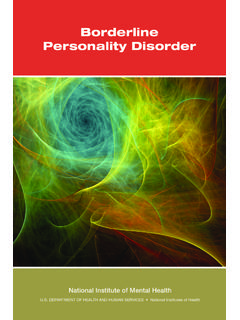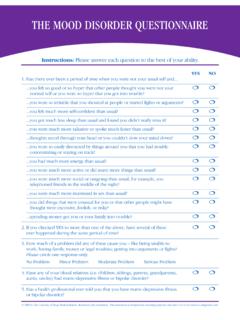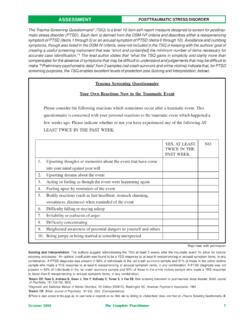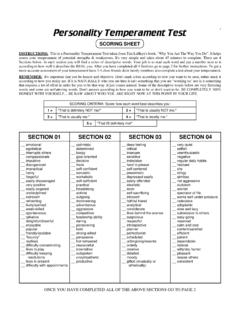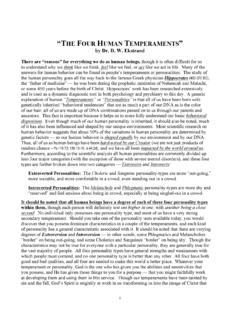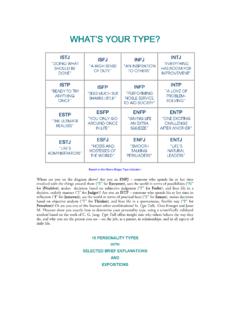Transcription of Borderline Personality Disorder - South African …
1 Borderline Personality Disorder National Institute of Mental Health Department of HealtH anD HUman ServiceS national institutes of Health Contents What is Borderline Personality Disorder ? _____ 1. What are the symptoms of Borderline Personality Disorder ? _____ 2. Suicide and Self-harm_____ 3. When does Borderline Personality Disorder start? _____ 4. What illnesses often co-exist with Borderline Personality Disorder ? _____ 4. What are the risk factors for Borderline Personality Disorder ? _____ 5. How is Borderline Personality Disorder diagnosed? _____ 5. What studies are being done to improve the diagnosis of Borderline Personality Disorder ?
2 _____ 6. How is Borderline Personality Disorder treated? _____ 7. Psychotherapy _____ 7. Medications _____ 10. Other Treatments _____ 10. How can I help a friend or relative who has Borderline Personality Disorder ? _____ 11. How can I help myself if I have Borderline Personality Disorder ? _____ 12. Where can I go for help? _____ 13. What if I or someone I know is in crisis? _____ 13. Citations _____ 14. For more information on Borderline Personality Disorder _____ 17. What is Borderline Personality Disorder ? Borderline Personality Disorder is a serious mental illness marked by unstable moods, behavior, and relationships.
3 In 1980, the Diagnostic and Statistical Manual for Mental disorders , Third Edition (DSM-III) listed Borderline Personality Disorder as a diagnosable illness for the first time. Most psychiatrists and other mental health professionals use the DSM to diagnose mental illnesses. Because some people with severe Borderline Personality Disorder have brief psychotic episodes, experts originally thought of this illness as atypical, or Borderline , versions of other mental While mental health experts now generally agree that the name Borderline Personality disor- der is misleading, a more accurate term does not exist yet. Most people who have Borderline Personality Disorder suffer from: Problems with regulating emotions and thoughts Impulsive and reckless behavior Unstable relationships with other people.
4 People with this Disorder also have high rates of co-occurring disorders , such as depression, anxiety disorders , substance abuse, and eating disorders , along with self-harm, suicidal behaviors, and completed suicides. According to data from a subsample of participants in a national survey on mental disorders , about percent of adults in the United States have Borderline person- ality Disorder in a given Borderline Personality Disorder is often viewed as difficult to treat. However, recent research shows that Borderline Personality Disorder can be treated effectively, and that many people with this illness improve over , 3, 4.
5 Borderline Personality Disorder 1. What are the symptoms of Borderline Personality Disorder ? According to the DSM, Fourth Edition, Text Revision (DSM-IV-TR), to be diagnosed with Borderline per- sonality Disorder , a person must show an enduring pattern of behavior that includes at least five of the following symptoms: Extreme reactions including panic, depression, rage, or frantic actions to abandonment, whether real or perceived A pattern of intense and stormy relationships with family, friends, and loved ones, often veering from extreme closeness and love (idealization) to extreme dislike or anger (devaluation). Distorted and unstable self-image or sense of self, which can result in sudden changes in feelings, opinions, values, or plans and goals for the future (such as school or career choices).
6 Impulsive and often dangerous behaviors, such as spending sprees, unsafe sex, substance abuse, reckless driving, and binge eating Recurring suicidal behaviors or threats or self-harming behavior, such as cutting Intense and highly changeable moods, with each episode lasting from a few hours to a few days Chronic feelings of emptiness and/or boredom Inappropriate, intense anger or problems controlling anger Having stress-related paranoid thoughts or severe dissociative symptoms, such as feeling cut off from oneself, observing oneself from outside the body, or losing touch with reality. 2 Borderline Personality Disorder Seemingly mundane events may trigger symptoms.
7 For example, people with Borderline Personality Disorder may feel angry and distressed over minor separations such as vacations, business trips, or sudden changes of plans from people to whom they feel close. Studies show that people with this Disorder may see anger in an emotionally neutral face5 and have a stronger reaction to words with negative meanings than people who do not have the Suicide and Self-harm Self-injurious behavior includes suicide and suicide attempts, as well as self-harming behaviors, described below. As many as 80 percent of people with Borderline Personality Disorder have suicidal behaviors,7 and about 4 to 9 percent commit , 7.
8 Suicide is one of the most tragic outcomes of any mental illness. Some treatments can help reduce suicidal behaviors in people with Borderline Personality Disorder . For example, one study showed that dialectical behavior therapy (DBT) reduced suicide attempts in women by half compared with other types of psychotherapy, or talk therapy. DBT also reduced use of emer- gency room and inpatient services and retained more participants in therapy, compared to other approaches to For more information about DBT, see the section, How is Borderline Personality Disorder treated? . Unlike suicide attempts, self-harming behaviors do not stem from a desire to die.
9 However, some self-harming behaviors may be life threatening. Self-harming behaviors linked with Borderline Personality Disorder include cutting, burning, hitting, head banging, hair pulling, and other harm- ful acts. People with Borderline Personality Disorder may self-harm to help regulate their emo- tions, to punish themselves, or to express their They do not always see these behaviors as harmful. Borderline Personality Disorder 3. When does Borderline Personality Disorder start? Borderline Personality Disorder usually begins during adolescence or early , 9 Some studies sug- Studies gest that early symptoms of the illness may occur during , 11.
10 Suggest early Some people with Borderline Personality Disorder experi- ence severe symptoms and require intensive, often inpa- symptoms tient, care. Others may use some outpatient treatments may occur but never need hospitalization or emergency care. Some people who develop this Disorder may improve without in childhood any What illnesses often co-exist with Borderline Personality Disorder ? Borderline Personality Disorder often occurs with other illnesses. These co-occurring disorders can make it harder to diagnose and treat Borderline person- ality Disorder , especially if symptoms of other illnesses overlap with the symptoms of Borderline Personality Disorder .
